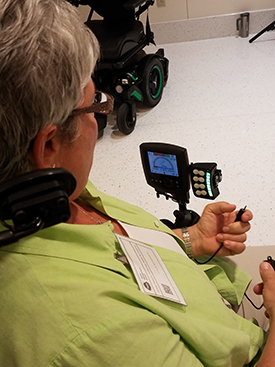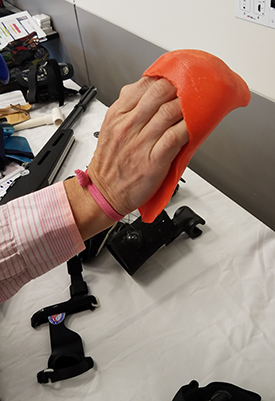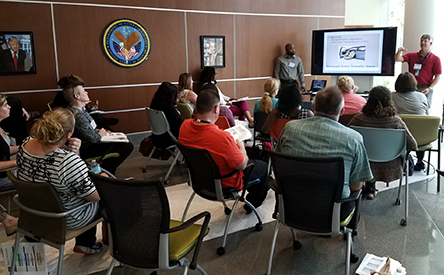VHA SimLEARN
Assistive Technology course helps staff make a difference in Veterans’ lives
By Gerald Sonnenberg
EES Marketing and Communication
ORLANDO, Fla. – Approximately 120 VHA staff participated in a “hands on” assistive technology course June 20-22 at the VHA SimLEARN National Simulation Center. It was sponsored by the Rehabilitation and Prosthetics Services Program Office of the VHA Physical Medicine and Rehabilitation (PM&R) Service.
The course exposed staff, such as physical therapists, occupational therapists, speech pathologists, recreation therapists, prosthetics staff, vocation rehabilitation counselors and others, to a wide variety of assistive equipment and technology. It demonstrated how technology can help Veteran patients living with varying physical disabilities, like missing limbs, traumatic brain injury, PTSD or paralysis, to be more active and reach their highest level of potential. Similar courses were conducted the past two years at Tampa, Florida and Long Beach, California; with this event at SimLEARN being the largest so far, according to Bill Wenninger, a rehabilitation planning specialist at PM&R based at the Milwaukee VA Medical Center (VAMC). He is the primary planner and coordinator of the event.
“The main mission (of the event),” said Wenninger, “is to make staff aware of the technology and help them understand the different scopes of technology available in certain areas like wheeled mobility or augmentative communication. It also helps them understand the prescription parameters for those devices, and to be able to network with others in case they have questions about the technology. The prescription parameters are dependent on the disability of the individual and the equipment being prescribed. It gives them an idea of what they can do for their patients when they get back to their facilities.”
In preparation for the course, a monthly assistive technology virtual training event gave attendees an overview of the equipment and assessments and recommendations before seeing them up close and handling the devices.
The breakout sessions addressed a variety of technologies in the areas of adaptive sports and recreation, drivers training (for VA staff), telehealth, augmentative communication, sensory (vision and hearing) devices, electronic cognitive devices, adaptive computer access, electronic aids to daily living and wheeled mobility and seating.
“This course is almost completely hands-on giving attendees the opportunity to understand how the equipment functions,” said Mona Wright, an Employee Education System staff member and project manager for the training. “Additionally, because the assistive technology experts are presenting, this gives attendees a chance to ask questions and discover device functions that they may not otherwise know. One attendee commented that being exposed to devices outside their focus area was beneficial when working with Veterans. They could suggest devices to complement their treatment focus and engage a multidisciplinary approach.”
Leslie Mangiapani is director of occupational therapy working in prosthetics at the Northern Indiana Health Care System in Marion, Indiana, and was one of the attendees. She had the opportunity to test some of the equipment, including a sophisticated wheelchair during the Wheeled Mobility breakout session.
“This (chair) is designed for Veterans who may have ALS (Amyotrophic Lateral Sclerosis), spinal cord injuries or other issues limiting their movement,” said Mangiapani. A VA employee for more than nine years, Mangiapani enjoys what she does for Veterans. “As therapists, we do much more than showing Veterans how to use equipment; we help change their environments. I love doing what I do, and it is amazing the difference I can help make in their lives.”
One of the more popular breakout sessions was demonstrated by staff from the James A. Haley VAMC Adaptive Sports Program in Tampa, Florida. They addressed something that many people may not realize is available; adaptive technology to participate in sports. Staff demonstrated a variety of equipment that can help Veterans become more active, such as an attachment for a Veteran with a missing hand to be able to grip the handlebar of a bicycle so they can ride again, or a specially molded grip so they can rock climb. Sports ranged from bowling, to target shooting, archery, and several other activities, and the equipment is often designed in house and specifically for a single Veteran.
“That’s part of the point of this is to make people aware and knowledgeable, as well as see the variety of technology available,” explained Wenninger. “It’s important to have them (staff) think about how to apply it to different patients they would come across; to talk about the technology, and how they would follow up with the technology to adjust it as the disability changes, or as the person gets more efficient with the product they have. It’s not a luxury item we’re trying to get to people. It really makes a difference in their independence and their overall function. I value the opportunity to provide this type of education to a wide variety of disciplines.”
For more information, please contact Bill Wenninger.

Leslie Mangiapani, director of occupational therapy working in prosthetics at the Northern Indiana Health Care System in Marion, Indiana, tests a specially modified wheel chair during the Assistive Technology training course. (VA photo by Gerald Sonnenberg)
This grip designed for a Veteran by the James A. Haley VAMC Adaptive Sports Program in Tampa, Florida, helps the Veteran continue his love of rock climbing. (VA photo by Gerald Sonnenberg)
VA staff attend training regarding operating and transporting Veterans in specially designed vans. (VA photo by Gerald Sonnenberg)



















